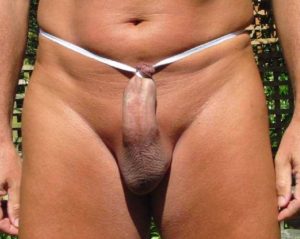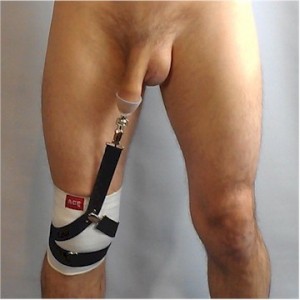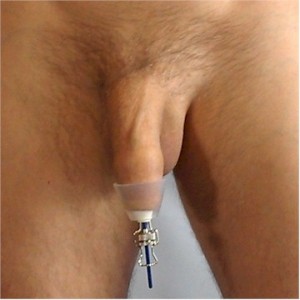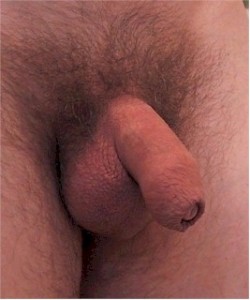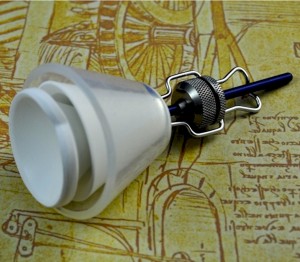Foreskin Restoration
 Foreskin restoration is the process of extending the skin on the penis in an effort to regain the functional benefits of the foreskin, removed by circumcision. This website empathises with those circumcised men whose circumcision was beyond their control and admires anyone who is in the process of restoring their foreskin. There’s an ever growing multitude of men, circumcised as neonates or in childhood, who have become deeply unhappy that they were deprived of their foreskins. Circumcised men can ‘reclaim’ their foreskins through foreskin restoration, which is primarily accomplished through non-surgical methods by expanding the residual skin to induce the growth of new skin tissue. Surgical techniques can also be utilised to re-establish a foreskin. It’s important to note however, that the nerve endings severed through circumcision can never be re-established. It’s been reported by some men who have restored their foreskin, that there’s an increase in the sensitivity of their penis and that the restored foreskin facilitates masturbation. It’s also been reported by others that restoration was a disappointment. This process however IS a very slow and lengthy one which calls for dedication, perseverance and patience.
Foreskin restoration is the process of extending the skin on the penis in an effort to regain the functional benefits of the foreskin, removed by circumcision. This website empathises with those circumcised men whose circumcision was beyond their control and admires anyone who is in the process of restoring their foreskin. There’s an ever growing multitude of men, circumcised as neonates or in childhood, who have become deeply unhappy that they were deprived of their foreskins. Circumcised men can ‘reclaim’ their foreskins through foreskin restoration, which is primarily accomplished through non-surgical methods by expanding the residual skin to induce the growth of new skin tissue. Surgical techniques can also be utilised to re-establish a foreskin. It’s important to note however, that the nerve endings severed through circumcision can never be re-established. It’s been reported by some men who have restored their foreskin, that there’s an increase in the sensitivity of their penis and that the restored foreskin facilitates masturbation. It’s also been reported by others that restoration was a disappointment. This process however IS a very slow and lengthy one which calls for dedication, perseverance and patience.
Foreskin restoration isn’t a new phenomenon as it stems of ancient origin and dates back to the reign of Emperor Tiberius, when surgical means were taken to lengthen the foreskin of individuals with either a short foreskin that did not cover the glans completely or a completely exposed glans as a result of circumcision. In classical Greek and Roman societies, exposure of the glans was considered improper, and did not conform to the Hellenistic ideal of gymnastic nudity. Men with short foreskins would wear the kynodesme to prevent exposure. As a consequence of this social stigma, an early form of foreskin restoration known as epispasm was practiced among some Jews in Ancient Rome. Again, during World War II some European Jews sought foreskin restoration to avoid Nazi persecution.
As previously stated, there are many circumcised men who have decided to restore their foreskins for a number of reasons. Bigelow (1992) states the following as reasons for restoring: “Aesthetics; Restoration of glanular sensation; Sexual stimulation and restored sexual function; Restoration of a sense of wholeness; Improvement of body image.” Foreskin restoration has been reported as having beneficial emotional results in some men, and has been proposed as a treatment for negative feelings in some adult men about their infant circumcisions that someone else decided to have performed on them.
 Various groups have been founded since the late 20th century, especially in North America where male neonate circumcision reached epidemic proportions of up to 90% of the male population. In 1982 the group Brothers United for Future Foreskins (BUFF) began to publicize non-surgical restoration. In 1989 the National Organization of Restoring Men (NORM) was founded as a non-profit support group for men undertaking foreskin restoration. In 1991 the group UNCircumcising Information and Resource Centers (UNCIRC) was formed which was incorporated into NORM in 1994. Several NORM chapters have been founded throughout the United States, as well as internationally in Canada, the United Kingdom, Australia, New Zealand, and Germany.
Various groups have been founded since the late 20th century, especially in North America where male neonate circumcision reached epidemic proportions of up to 90% of the male population. In 1982 the group Brothers United for Future Foreskins (BUFF) began to publicize non-surgical restoration. In 1989 the National Organization of Restoring Men (NORM) was founded as a non-profit support group for men undertaking foreskin restoration. In 1991 the group UNCircumcising Information and Resource Centers (UNCIRC) was formed which was incorporated into NORM in 1994. Several NORM chapters have been founded throughout the United States, as well as internationally in Canada, the United Kingdom, Australia, New Zealand, and Germany.
Non-surgical foreskin restoration, accomplished through tissue expansion, is the more commonly used method. Both the skin of the penile shaft and the mucosal inner lining of the foreskin, if any remains after circumcision, may be expanded. Tissue expansion has long been known to stimulate mitosis, and research shows that regenerated human tissues have the attributes of the original tissue. Unlike conventional skin expansion techniques, however, the process of non-surgical foreskin restoration may take several years to complete. The time required depends on the amount of skin available to expand, the amount of skin desired in the end, and the regimen of stretching methods used. Patience and dedication are needed with restoring support groups to help with these. The act of stretching the skin is often described as “tugging”. During restoration via tissue expansion, the remaining penile skin is pulled forward over the glans, and tension is maintained either manually or through the aid of a foreskin restoration device. Manual methods are often used by men first starting restoration, but can be used at any stage of the restoration process, and refers to the necessity of the restorer to manually maintain the tension by holding the skin tautly with his fingers using one of several variations in finger placement.
There are several websites which promote foreskin restoration and many men have found the process of restoration beneficial and satisfying. The usual technique is to pull on and stretch the remaining skin, which as it becomes lengthier, becomes easier to ‘train’. Many men have successfully restored their foreskins and are truly happy with the result and wholeheartedly recommend undergoing this process. One of the predominant foreskin restoration websites promotes the TLC tugger which is the creation of Ron Low, an engineer who’s turned his engineering know-how and skills to invent and develop devices and equipment to facilitate the process of foreskin restoration.
Surgical methods of foreskin restoration, known as foreskin reconstruction, usually involve a method of grafting skin onto the distal portion of the penile shaft. The grafted skin is typically taken from the scrotum, which contains the same smooth muscle (known as dartos faccia) as does the skin of the penis. One method involves a four-stage procedure in which the penile shaft is buried in the scrotum for a period of time. Such techniques are costly, and have the potential to produce unsatisfactory results or serious complications related to the skin graft. Drew Okun once known as Al Parker (an adult film star) speaks positively about his surgical restoration in a video on this page. If anyone was contemplating this route then obvious research, discussion and caution would be recommended before undertaking such an important decision.
The National Organisation of Restoring Men (NORM) norm.org provides a forum for circumcised men to share their concerns about restoring, as well as advice and support to restore their foreskins. They also have a page on their website which lists a comprehensive array of restoration techniques and devices for men to make informed choices / decisions about which process or technique to utilise. This can be accessed through this link here
